Google Analytics 4 (GA4) segments are filters that cut through your data noise, showing you exactly which customers, visits, or actions matter most to your store’s success.
Creating segments is especially useful for ecommerce because they show you exactly which customer groups bring in the most revenue.
They also help you identify your best marketing channels and spot where customers leave your purchase funnel.
In this guide, you’ll learn:
- How to set up segments in Google Analytics (GA4) with clear steps
- What each segment type does and when to use it
- Which segments work best for online stores, from tracking customer behavior to analyzing sales patterns
Let’s start by understanding the basics of segments and finding the right ones for your online store:
| Segment Types | Best For |
| User Segments | Small to mid-size stores focusing on customer loyalty, subscription-based businesses, stores with long customer lifecycles |
| Session Segments | High-traffic stores, businesses with short purchase cycles, stores running multiple campaigns |
| Event Segments | Stores optimizing their purchase funnel, sites with complex user journeys, product launch monitoring |
| Advanced Condition Segments | Stores with complex customer bases, multi-channel retailers, businesses with varied product lines |
How to Create Segments in Google Analytics (GA4)
Before building segments in GA4, start with a clear goal like tracking high-value customers or analyzing cart abandonment.
This approach will help you create segments that give you exactly the data your store needs.
Here’s your step-by-step guide on creating segments in Google Analytics (GA4):
Please Note:
- Start with one condition per segment to test if it’s tracking correctly
- Name your segments with a consistent pattern (like “Users_HighValue” or “Session_CartAbandon”)
- Preview your segment data before saving to make sure it’s capturing the right information
- Always test your segments with a small data sample first before using them for major business decisions.
Basic Segments in Google Analytics (GA4)
Understanding the main segment types in GA4 helps you choose the right one for your analysis.
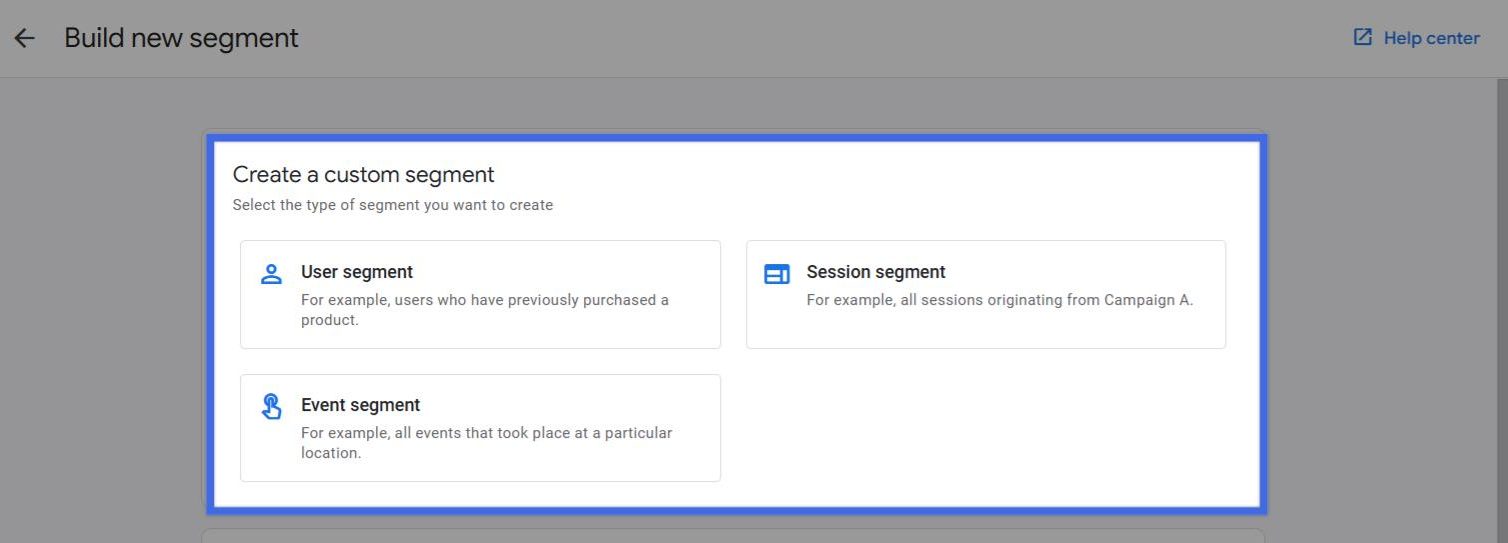
Let’s look at each type of segments in Google Analytics 4 (GA4) and when to use them:
User Segments
User segments track individual customers across all their interactions with your store.
These segments in Google Analytics 4 (GA4) follow standard segment creation steps but focus on user properties in the condition builder.
User segments in Google Analytics 4 (GA4) are best for:
- Small to mid-size stores focusing on customer loyalty
- Subscription-based businesses
- Stores with long customer lifecycles
You can use user segments to analyze:
- Total purchase value per customer
- Number of visits before purchase
- Device preferences
- Favorite product categories
- Geographic locations
Session Segments
Session segments show how visitors interact with your store in a single visit.
Create these by selecting ‘session’ as your scope in the segment builder.
Session segments in Google Analytics 4 (GA4) are best for:
- High-traffic stores
- Businesses with short purchase cycles
- Stores running multiple campaigns
You can use session segments to analyze:
- Session duration
- Pages viewed per visit
- Cart interactions
- Campaign effectiveness
- Landing page performance
Event Segments
Event segments monitor specific actions on your store.
Set these up by choosing ‘event’ as your segment type and selecting your target actions.
Event segments in Google Analytics 4 (GA4) are best for:
- Stores optimizing their purchase funnel
- Sites with complex user journeys
- Product launch monitoring
You can use event segments to analyze:
- Product views
- Add-to-cart actions
- Checkout starts
- Purchase completions
- Search queries
Advanced Condition Segments
These segments use multiple conditions and combinations.
Create them by adding multiple rules in your segment setup.
Advanced condition segments in Google Analytics 4 (GA4) are best for:
- Stores with complex customer bases
- Multi-channel retailers
- Businesses with varied product lines
You can use advanced condition segments to analyze:
- Combined user and session behaviors
- Multi-channel interactions
- Complex purchase patterns
- Custom event sequences
- Advanced conversion paths
Google Analytics (GA4) Segments for Ecommerce Businesses
Every ecommerce store needs to understand its customers better and understanding segments is the first step of this.
Let’s look at different segment types that are specifically useful for online stores:
Geographic and Time-Based Segments in Google Analytics 4 (GA4)
Geographic and time-based segments in Google Analytics 4 (GA4) help you understand where and when your customers shop.
These patterns reveal important insights for inventory management and marketing timing.
Regional Purchase Patterns
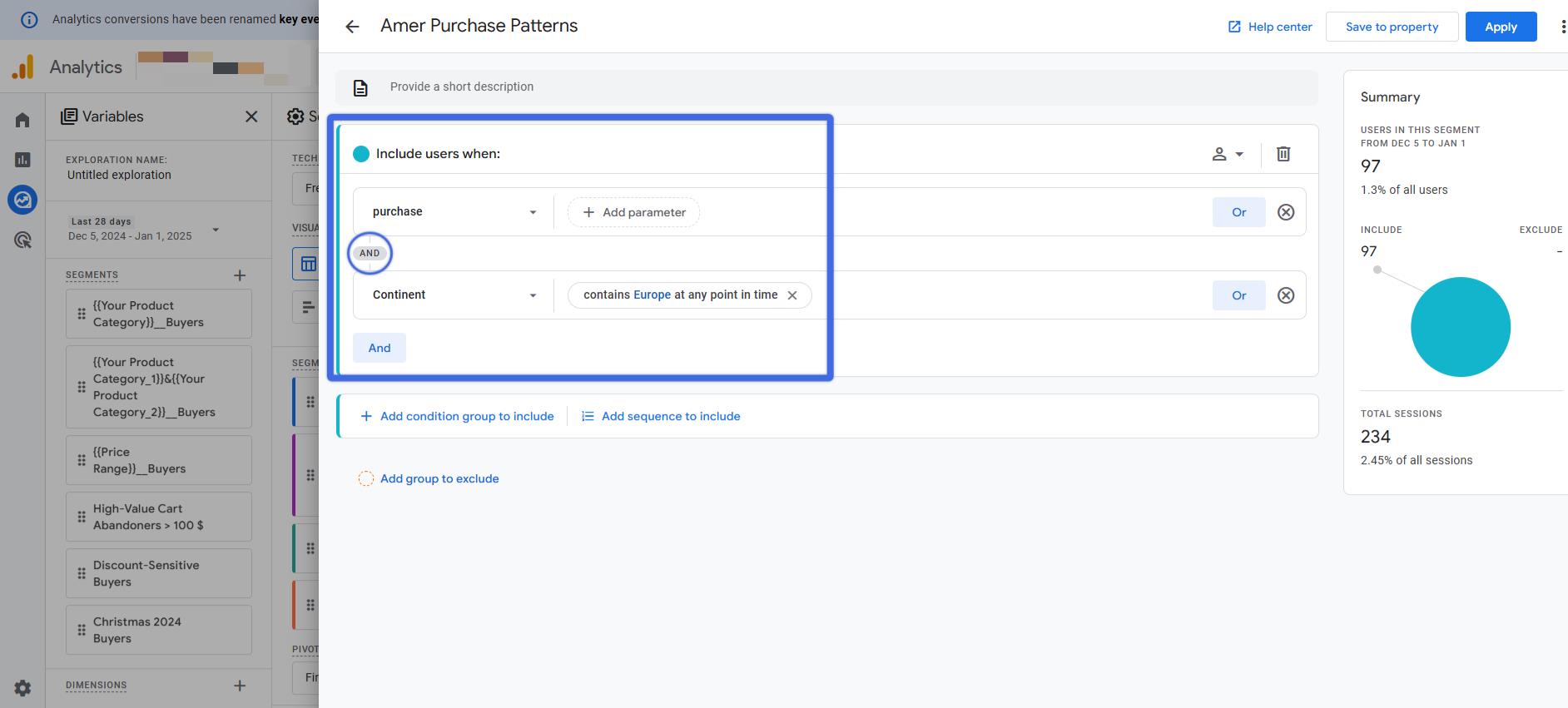
These segments in Google Analytics 4 (GA4) group customers by location. Track which products sell best in different regions and how shopping habits vary by area.
Understanding regional differences helps you tailor your marketing. You’ll see which products to promote where, and how to adjust pricing for different markets. This helps with inventory distribution and local marketing campaigns.
Time-of-Day Shoppers
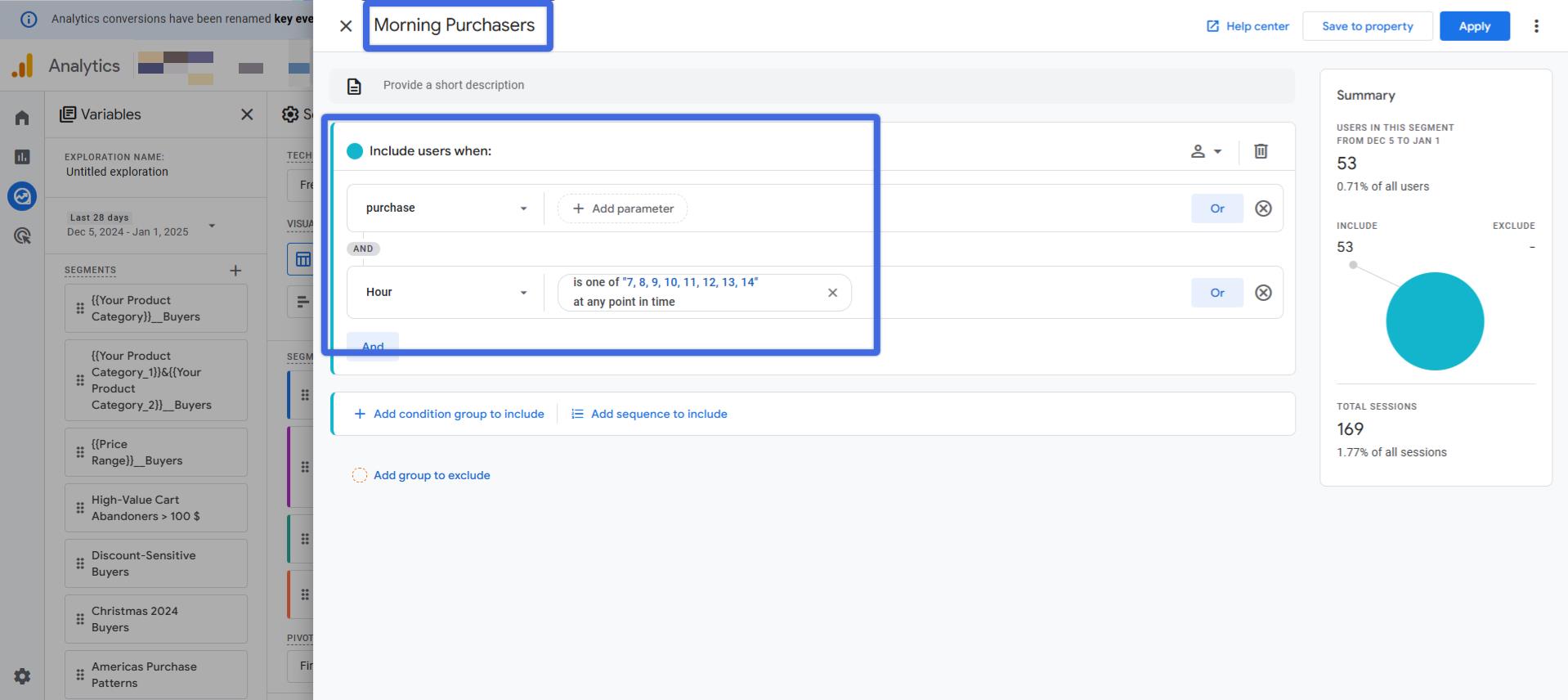
These segments in Google Analytics 4 (GA4) show when different customer groups prefer to shop. Create segments for morning shoppers, lunch-time browsers, and evening buyers.
Knowing peak shopping hours helps you time your marketing better. You’ll learn when to send emails, when to post on social media, and when to launch promotions for maximum impact.
International vs Domestic
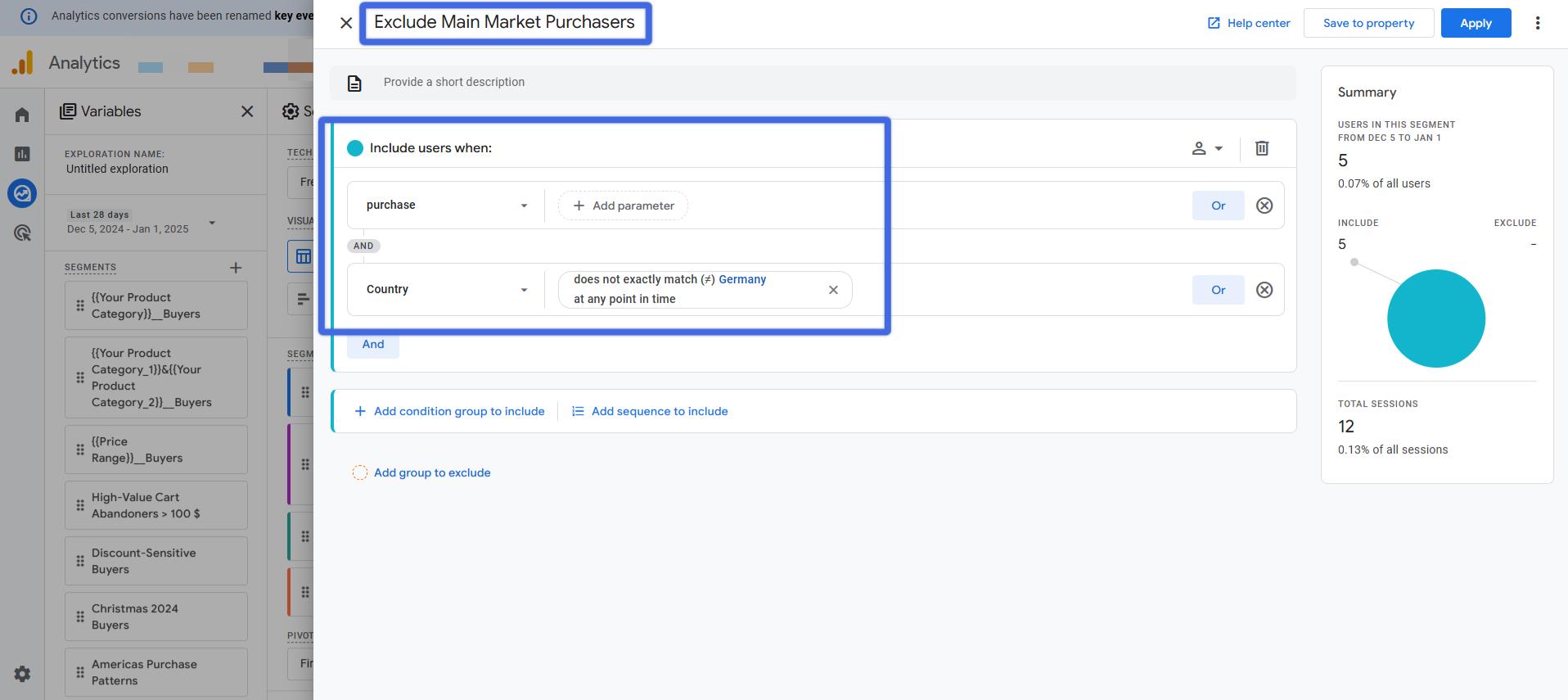
These segments separate local and international customers. Track how buying behavior differs between domestic and international shoppers.
This helps you understand shipping preferences, price sensitivity, and product preferences by market. Use these insights to improve your international marketing and shipping strategies.
Customer Lifecycle Segments in Google Analytics 4 (GA4)
Customer lifecycle segments in Google Analytics 4 (GA4) track your customers through different stages of their relationship with your store. These segments show you exactly who needs attention and what kind of marketing works best for each group.
First-time vs Returning Customer Segments

First-time customers are testing your store, while returning customers already trust you. Creating separate segments in Google Analytics 4 (GA4) for each helps you send the right messages.
You can easily use the New / Returning dimension generated by Google Analytics 4 based on its own User ID. Please note that since this dimension is device-based, it will assign a user as “New” if they connect from different devices. For more reliable segmentation, you can achieve this in a customized way by sending your own custom dimension.
For first-time customers, create a user segment with ‘New / Returning = New’. This shows you how new buyers shop, what products attract them, and their typical order value. You can use this data to improve your new customer experience and welcome campaigns.
 For returning customers, set up a user segment with ‘New / Returning = Returning’. This segment reveals what keeps customers coming back, their favorite products, and how their spending changes over time. Use these insights to strengthen your loyalty programs.
For returning customers, set up a user segment with ‘New / Returning = Returning’. This segment reveals what keeps customers coming back, their favorite products, and how their spending changes over time. Use these insights to strengthen your loyalty programs.
VIP Customer Segments
VIP customers often generate most of your revenue. Create a user segment based on total purchase amount and frequency. For example, set conditions for customers who spend over $500 in 6 months or buy more than 5 times.
This segment in Google Analytics 4 (GA4) shows you what your best customers have in common. You’ll see their favorite products, shopping times, and how they respond to different promotions. This information helps you turn more customers into VIPs.
At-risk Customer Segments
These segments in Google Analytics 4 (GA4) catch customers showing signs of leaving. Create a user segment tracking customers whose purchase frequency has dropped or who haven’t bought in a while.
This segment alerts you before customers leave completely. You can spot patterns like seasonal shopping, response to certain products, or price sensitivity. Use this information to create targeted rescue campaigns.
Dormant Customer Segments
Dormant segments in Google Analytics 4 (GA4) find customers who’ve stopped engaging with your store. Set up a user segment for people with no purchases or site visits in your chosen timeframe (like 90 days).
This segment helps you understand why customers leave and when they typically drop off. You can test different win-back offers and see which customers are worth trying to bring back.
Product-Based Segments in Google Analytics 4 (GA4)
Product-based segments in Google Analytics 4 (GA4) help you understand how customers interact with different items in your store. These insights help you make better inventory and marketing decisions.
Before getting into the details of product-based segments in Google Analytics 4 (GA4), make sure to check out our post on “Product Performance Analysis in Google Ads” post, including the key reports for ecommerce businesses!
Category-Based Customer Segments

These segments in Google Analytics 4 (GA4) group customers by their product category preferences. Create segments for customers who buy from specific categories. This shows you which categories drive customer to sale.
You’ll learn which categories attract first-time buyers, which ones lead to repeat purchases, and where customers come from to buy your products for example organic, paid, or direct. Use this to improve category layouts and ad strategies.
Cross-Category Purchase Behavior
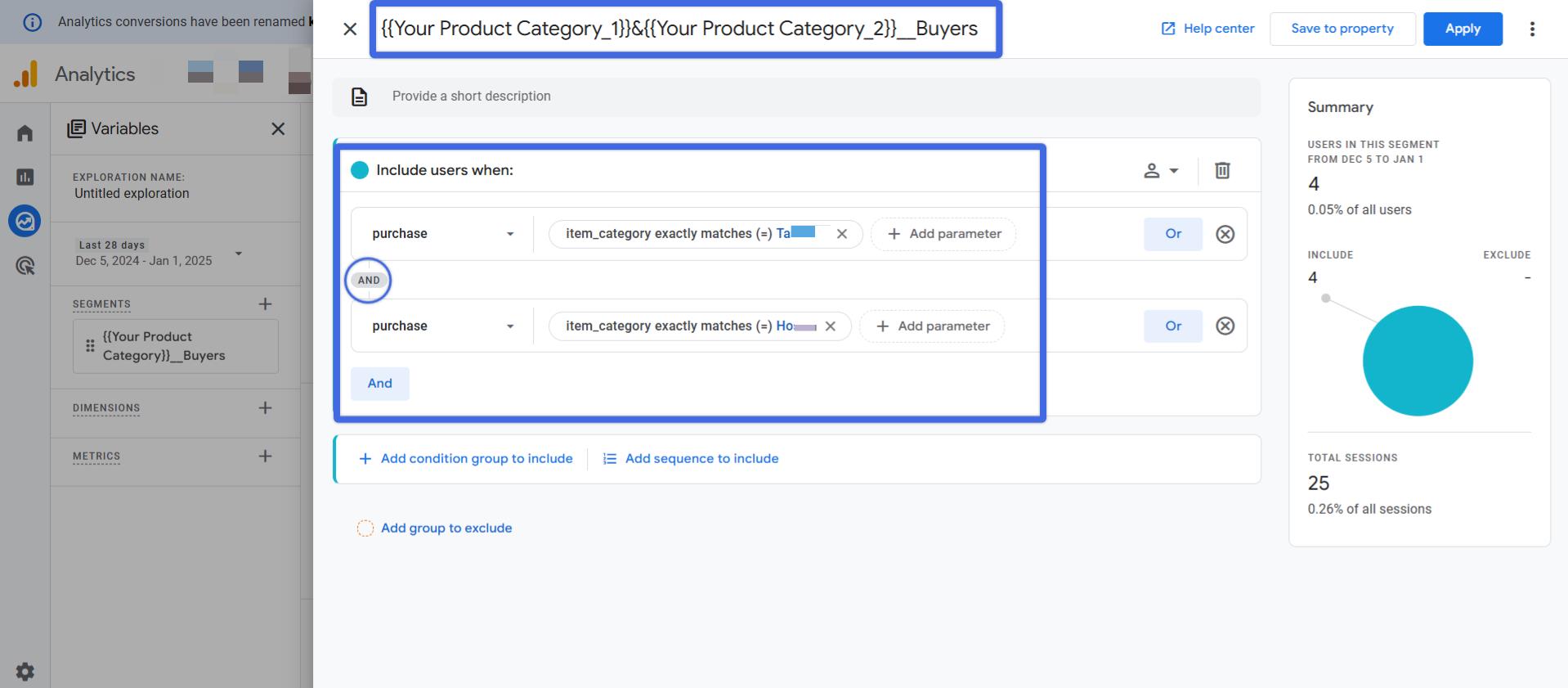
These segments in Google Analytics 4 (GA4) show you customers who buy from multiple categories. Track customers who purchase across different product types in a single order or over time.
This reveals natural product combinations and category relationships. You can use these insights to create better product bundles and improve your recommendation system.
Price Point-Based Segments

These segments group customers by their spending patterns. Create segments in Google Analytics 4 (GA4) for customers who buy premium items versus those who prefer budget options.
This helps you understand price sensitivity across different platforms and available data on your GA4 property. Use these insights to adjust your pricing strategy and create targeted promotions.
Purchase Behavior Segments in Google Analytics 4 (GA4)
Purchase behavior segments in Google Analytics 4 (GA4) show you how different customers buy from your store. Understanding these patterns helps you improve your marketing and store experience.
High-Value Cart Abandoners
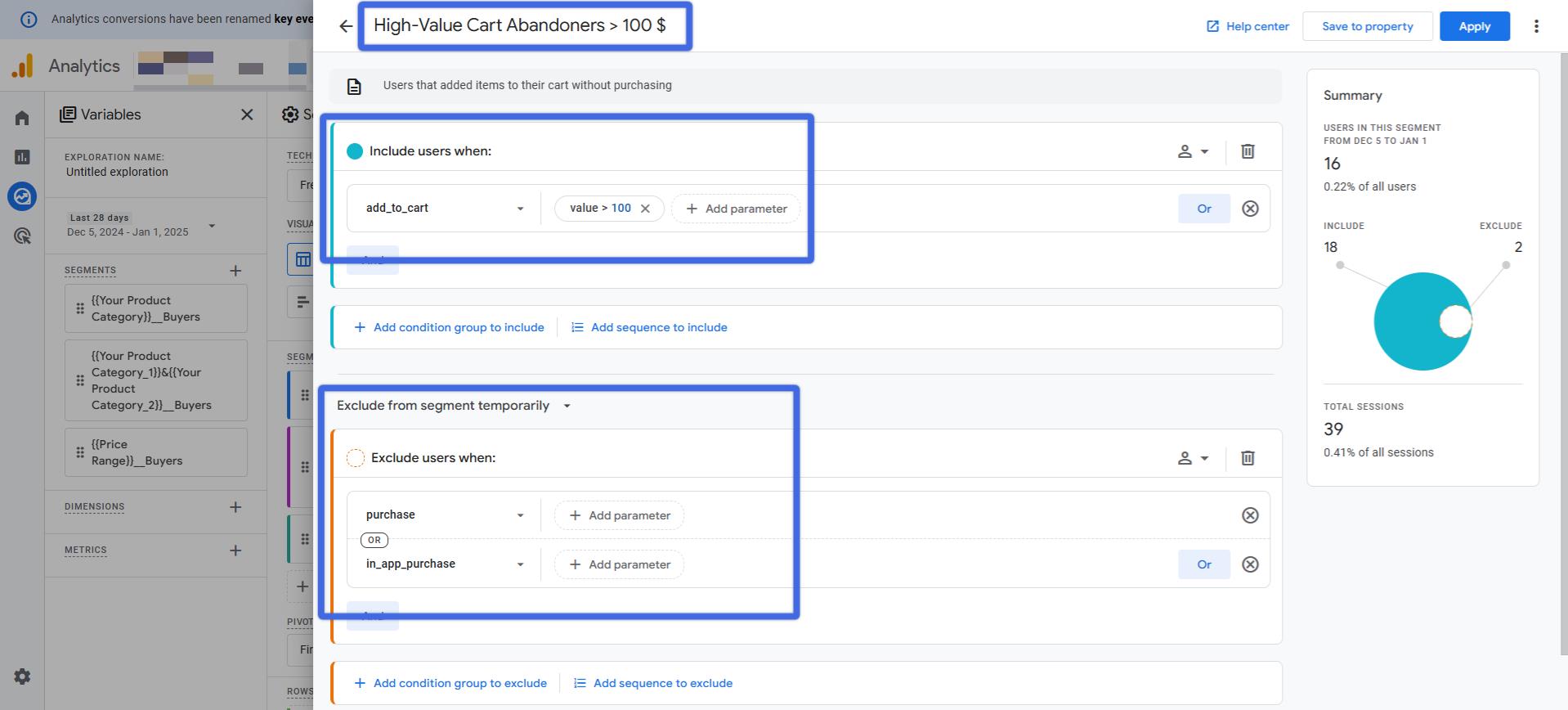
These customers add expensive items to cart but don’t complete purchase. Create segments in Google Analytics 4 (GA4) to track visitors who abandon carts worth more than your store’s average order value.
By analyzing these segments, you’ll spot common reasons for expensive cart abandonment. Use this data to adjust your checkout process or create targeted cart recovery campaigns.
Discount-Sensitive Buyers
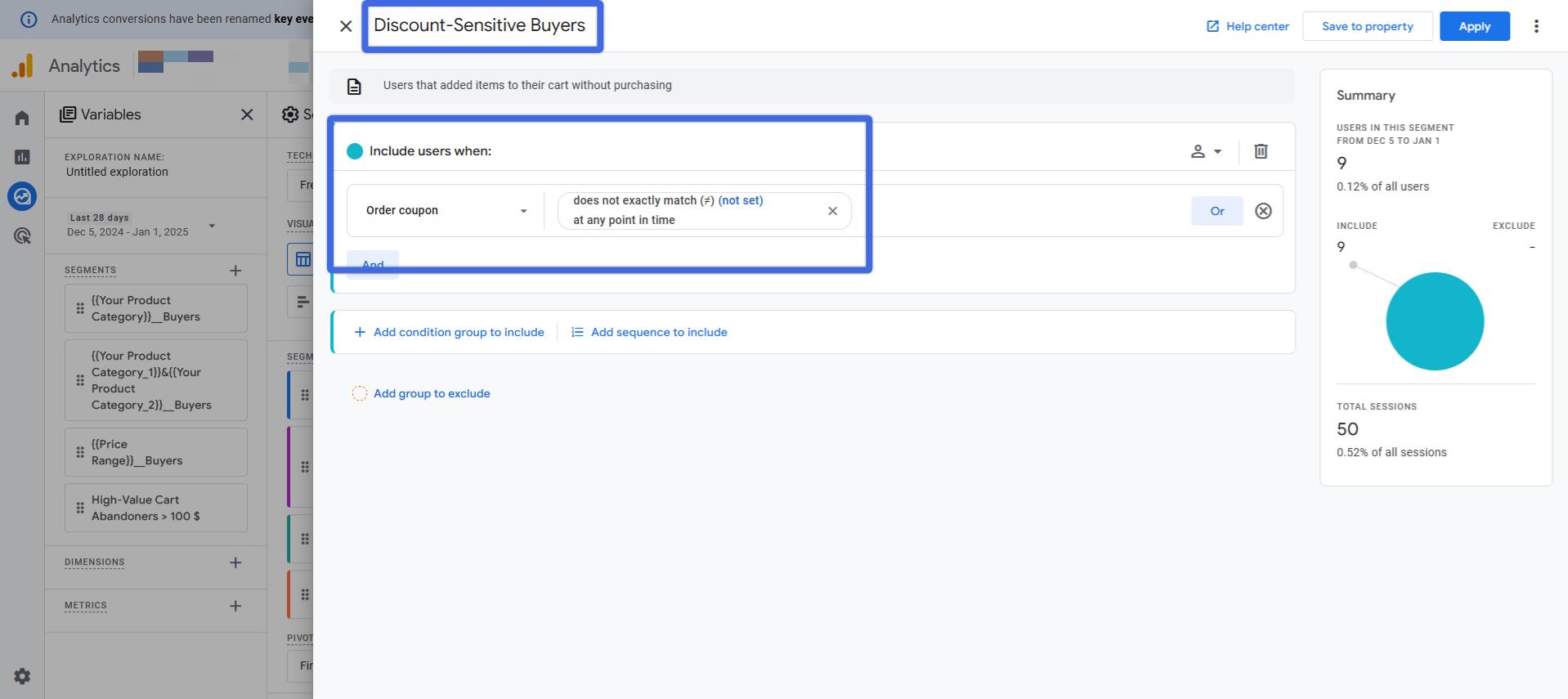
These segments in Google Analytics 4 (GA4) identify customers who mainly buy during sales. Track customers who purchase with discount codes or during promotional periods.
Understanding discount sensitivity helps you plan promotions better. You’ll see which customer groups need discounts to convert and which will buy at full price.
Seasonal Shoppers
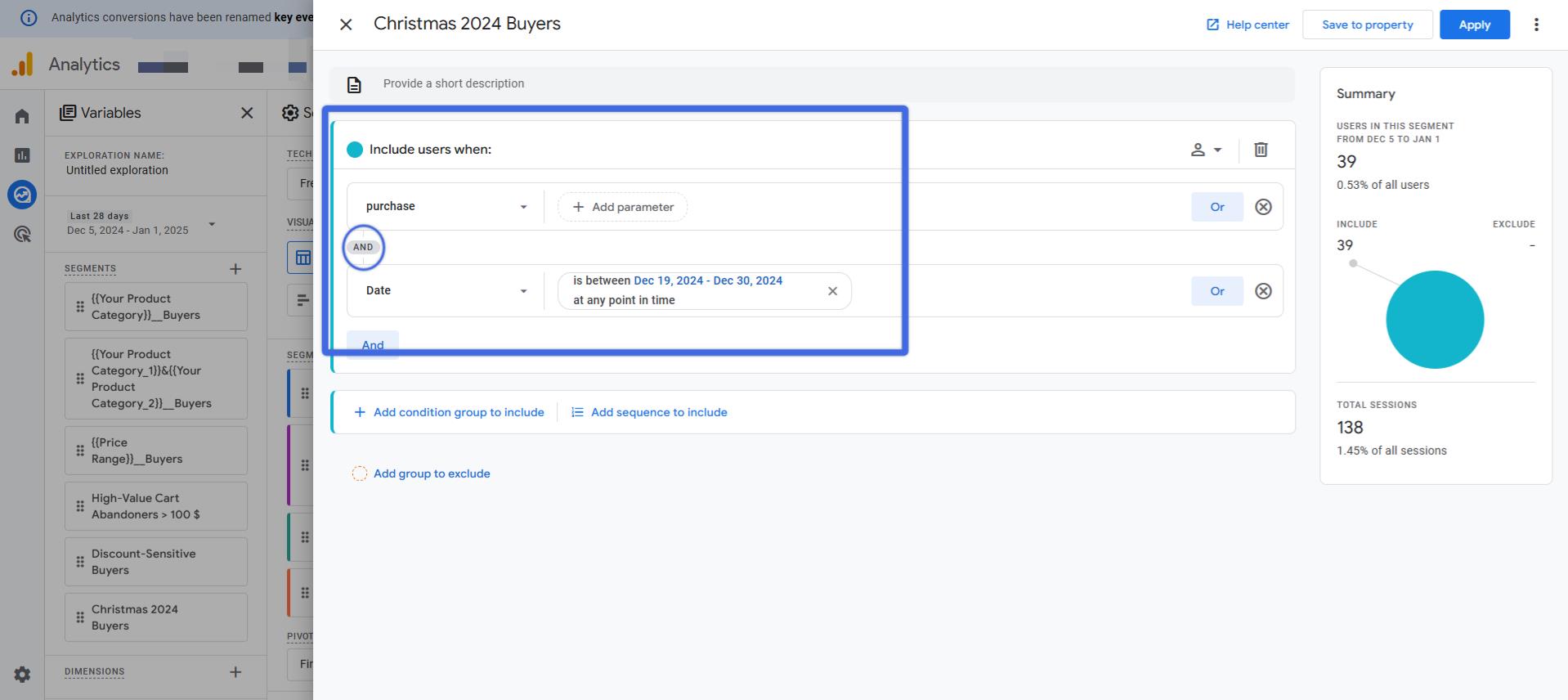
These segments group customers by their shopping seasons. Create segments for holiday shoppers, back-to-school buyers, or summer sale customers.
Understanding seasonal patterns helps you prepare for busy periods. You’ll know when certain customers are likely to return and what they’ll buy.
Marketing Response Segments in Google Analytics 4 (GA4)
Marketing response segments in Google Analytics 4 (GA4) show how customers react to different marketing channels and campaigns. These insights help you spend your marketing budget more effectively.
Email Campaign Responders

These segments track how customers interact with your email marketing. Create segments in Google Analytics 4 (GA4) for customers who purchase from email campaigns.
Understanding email response patterns helps improve your email strategy. You’ll see which email content works best and which customers are most likely to buy through email campaigns.
Search Traffic Buyers

These segments in Google Analytics 4 (GA4) identify customers who find you through search engines. Track organic and paid search visitors who convert to customers.
Understanding search traffic helps you improve your SEO and paid search strategies. You’ll see which keywords and campaigns bring in the most valuable customers.
Direct Traffic Purchasers
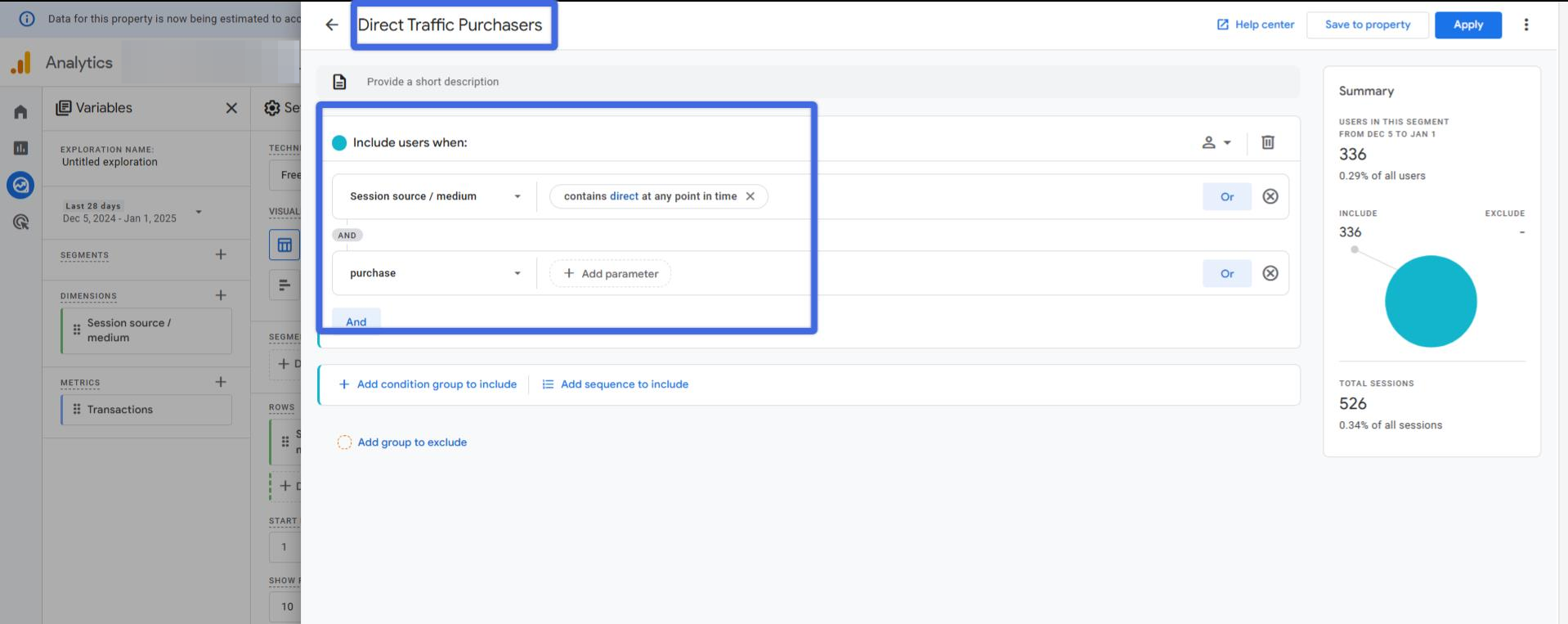
These segments in Google Analytics 4 (GA4) show customers who come directly to your store. Track repeat visitors and their buying patterns.
This helps you understand your brand strength. You’ll see which customers know your store well enough to visit directly and what they typically buy.
Referral Source Performance

These segments in Google Analytics 4 (GA4) group customers by their original traffic source. Compare customer value and behavior across different referral channels.
This shows which marketing channels bring in the best customers. Use these insights to focus your marketing budget on the most effective channels.
Frequently Asked Questions About Google Analytics 4 (GA4) Segments
Here are the frequently asked questions about ecommerce segments in Google Analytics 4:
What are Google Analytics 4 (GA4) segments and why are they important for ecommerce?
GA4 segments are essential filters that help you cut through data noise to show exactly which customers, visits, or actions matter most to your store’s success. They are particularly important for ecommerce because they reveal which customer groups generate the most revenue and help identify the best marketing channels while spotting where customers leave your purchase funnel.
What are the main types of segments in GA4?
GA4 offers four main types of segments to analyze different aspects of your data. User Segments track individual customers across all interactions with your store. Session Segments show visitor interactions in a single visit. Event Segments monitor specific actions on your store. Advanced Condition Segments use multiple conditions and combinations for complex analysis.
How do I create segments in Google Analytics 4?
Creating segments in GA4 requires a methodical approach. Start with a clear goal for what you want to track. Begin by implementing one condition per segment to ensure proper tracking. Use a consistent naming pattern for your segments. Before finalizing, preview your segment data to verify accuracy. Always test your segments with a small data sample before using them for major business decisions.
What’s the difference between first-time and returning customer segments?
First-time customers are testing your store, while returning customers already trust you. You can create separate segments using the New/Returning dimension in GA4. Understanding first-time customer behavior helps improve new customer experience and welcome campaigns, while analyzing returning customer patterns reveals what keeps customers coming back and how their spending evolves over time.
How can I identify VIP customers using segments?
VIP customer segments can be created by focusing on total purchase amount and frequency. For instance, you might track customers who spend over $500 in 6 months or make more than 5 purchases. This segmentation reveals common characteristics among your best customers and provides insights on converting more customers into VIPs.
What are product-based segments and how do they help?
Product-based segments reveal how customers interact with different items in your store. These segments show category preferences, cross-category purchase behavior, and price point patterns. This information guides inventory decisions, marketing strategies, and helps optimize category layouts and advertising approaches.
How can segments help with cart abandonment?
High-value cart abandoner segments track visitors who leave items in their cart worth more than your store’s average order value. This segmentation helps identify patterns in expensive cart abandonment, allowing you to refine your checkout process and develop targeted cart recovery strategies.
What are marketing response segments and why are they important?
Marketing response segments illuminate how customers interact with different marketing channels and campaigns. By tracking email campaign responses, search traffic conversions, direct traffic purchases, and referral source performance, you can understand which channels bring in the most valuable customers and optimize your marketing budget accordingly.
How can geographic and time-based segments improve my store?
Geographic and time-based segments provide crucial insights into where and when customers shop. These segments uncover regional purchase patterns, preferred shopping times, and differences between international and domestic customers. This knowledge enables better inventory management, marketing timing, and international shipping strategies.
How do I track seasonal shopping patterns using segments?
Seasonal shopper segments group customers by their shopping seasons, including holiday shoppers, back-to-school buyers, and summer sale customers. Understanding these patterns helps you prepare inventory and marketing campaigns for peak periods, predict customer return timing, and anticipate their purchasing needs.
Conclusion
Now you know how to create and use segments in Google Analytics 4 (GA4) to better understand your store’s performance. Segments help you track different types of customers, understand shopping patterns, find your best marketing channels, and spot problems in your purchase funnel.
Remember to start with basic segments in Google Analytics 4 (GA4) and build up to more complex ones as you get comfortable. Focus on segments that matter most for your store goals.
Your next step is to create your first basic segment. Pick one customer group you want to understand better, and use that data to improve one area of your store.
Read More:

































